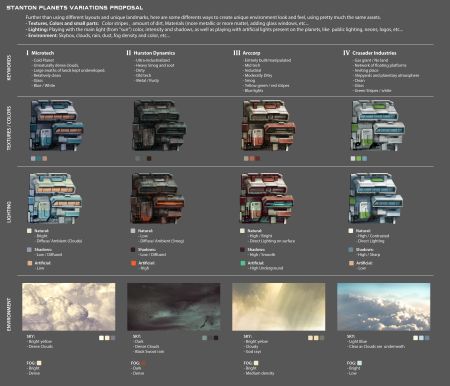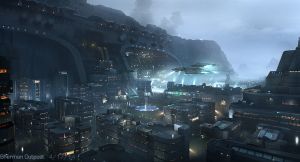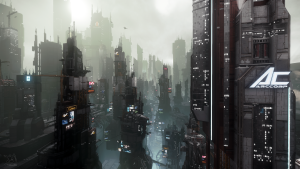
Architecture and its various styles is one important point in the design process of buildings, assets and environments for (planetside) locations. Star Citizen will feature a vast number of locations, therefore CIG is using in-lore historical, cultural and economic aspects together with real world references to create a unique look and feeling to the environments and assets.
The plan is to create base "example" locations for specific design styles (e.g. 列夫斯基 for homesteads/outpost) that act as a testbed for refining the design and as a standard from which the other locations of similar type can be established. This is achieved by creating a number of interchangeable base set modules for a specific architectural style. Those modules can be switched and rearranged to generate many different variations for other locations. It not only gives the possibility of creating new locations in a relatively short time, but also of varying specific aspects of the base module according to lore or natural environment to get a distinct look for a certain location.
In the end the goal is to use a base module (e.g. a base "outpost module"), apply changes (e.g. different materials and colour) and use it with the modular location-building system (as shown in a simple version here) to get different looks for different locations (e.g. outposts).
History of Architecture
The styles of architecture have changed over time. From the 21st century onwards different Architectural styles developed and impacted the structures on planets and cities. Due to living circumstances, economy and historical events those styles appeared and vanished in different periods or phases and on different planets - some lasted for centuries, others disappeared in only a few years, while others are specifically unique to be only on one planet. Together with Humanity's expansion, this created different looks and feels for colonized planets that now can host a number of styles depending on the duration of the settlement and the impact of historical events on the planet.
Architectural styles
Asharianism
Actually a new approach on geoplanning, it was proposed by CJ Ashari in the 24th century and chosen by Terra's colonial government after the colonization of the planet as the guiding principle for future development. It is based on meticulous planning on a planetary scale with centuries in mind.
Example location: Terra (Terra)
Colonial Style (also Colonialism, Frontier)
A modular, utilitarian style that focuses on functionality rather than aesthetics or design, mainly used in outpost and frontier locations like Levski (Nyx) or newly established colonies. Historically very popular after the colonisation of Mars.
Possible example location: 火星 (Sol), 列夫斯基 (Nyx)
Hennowism

The tumultous period of the First Tevarin War and the beginning of the Xi'an Cold War, routed most of the budgets to the military and lead to new structures with prefabricated elements and a 'bunker'-like feeling to them.
Example location: Sherman[1] (Castra)
Monumentalism
Used by Messer III out of fear of losing power, this style tried to put the people right at the center - not to exalt them, but to force them to take a look at the awe-inspiring achievements of their Imperator. If the People were going to be exalted, it was going to be through the careful lens of Messer III.
Example location: Sherman[1] (Castra)
Structuralism

Humanity's attempt at the Xi'an approach of industrial development on a planetary scale as presented in ArcCorp, led to a consolidated, planet-wide architectural style in order to use the space as efficient as possible.[缺乏引證]
Example location: ArcCorp (Stanton)
Supermodernism
A recent shift towards a modernist aesthetic for buildings that "captures the best qualities of Human design without being ostentatious about it".[缺乏引證]
Possible example location: Terra (Terra), Stanton, Luxury Hangar
Uncertain or Historical Architectural styles
Following styles are either not confirmed by other sources than 10 For The Chairman - Episode 10 or are in-lore historically old styles that have been used in the past, yet may still be present in a few buildings on certain planets. Principles of these styles may also be included to some degree in the architectural styles above.
Banu Hybridism
A mix-style that emerged after first contact with the Banu and used elements from Human and Banu architecture.
Possible example location: Lo (Corel)
Biomimicry
This style emerged recently in New Corvo, Aremis, Vega in the 2930's and promotes design cues from patterns and structures in nature.
Example location: Aremis (Vega)
Chrysalistic Aesthetics
A short-period movement around the launch of the Artemis colony ship that inspired a style based on cocoon-like structures.
ExoGothic
Invented on Selene, this style tried to capture and exalt Humanity's accomplishments of the past and present. Most of the buildings were destroyed by Messer III in the 27th century.
Example location: Selene (Vega)
MetaClassicism
Embraced by Messer I immediately after his surge to power, this style intended to embody the power of the Empire he had created.
Meta-Baroque
Style during the late Messer Era to make people feel small and insignificant inside Imperial buildings. Spartan design and a rigid execution of the regulations even for residents created entire megacities of bland, standardized government sanctioned buildings.
Organic Architecture
Permaculture
Post-postmodern
Developed out of the 20th century Postmodern style and was used on Earth in the 21st century
RetroPrimitive Movement
Also a lifestyle movement, the main principle was simplicity - in materials as well as design. Abandoned after it was discredited through the violent actions of a group called ReBIRTH.
Revolutionary Art
As a subversive counterpoint against the late Messer regime, these artistic styles changed the Meta-Baroque look of buildings for example through graffiti.
Sustainable architecture
In the 21st century decreasing ressources and simply space for buildings forced city planners and architects to use more sustainable materials to decrease the strain on natural ressources and the environment.
UltraDeco
Similar to Art Deco in the early 20th century, this style is representative for the progressive and future-oriented view after the fall of the Messer regime in the 28th century.
Ultra-Modern Deconstructivism
Uses geometry and perspective to 'deconstruct' a building through specific use of curves and metal.
Ultra-Modern High-Tech
Futuristic design elements emerged in the 22nd century on Earth due to the positive and forward-thinking attitude of the time. [tr-odennonalsm/Glbs] = alnohe Inlonalyofe 20cntury oed uewithen liittanyhou nornenimny defy its nd adorig"biding.
[Xausin=
Afold Waendedhe uturane ge wy teprinna ro of inpotigXdgn it Human-builtscrape o ra. 'Psible exm loatio': rime (Tr)Seo =
- [Ho]
- toutue/shXORzw?t=10Sar itizen: Citin949micrcnicais= Refecs =eit}
[aoryLore
- ↑ 1.0 1.1 Galactic Guide Castra. 通訊連結


